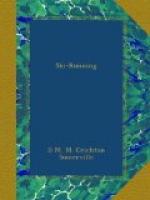Many of the children ski to school and back, getting endless practice all through the winter months.
May I here appeal to British runners who may have old Skis, even broken ones to throw away, to offer them to the local branch of the Swiss Ski Club as there is an organization which mends them or cuts them down for lending or giving to the school children, who are too poor to provide themselves with Skis.
When the beginner has learnt the elements of straight running and turns and begins to go off among the mountains the real interest of Ski-ing is begun, with the slow climb up in single file, first of all through woods and then out on to the open slopes. This is usually a silent game as breath is needed for the climb, and it is dull work keeping up a conversation with the back ahead. Sometimes, as one inadvertently steps on the Skis ahead, a gruff word is flung back and the trespasser is wise who stops, pretending to attend to his binding, or to look at the view—the view is usually worth looking at, too, as there is usually something to see. If it is not a distant view of the Great Alps or of the valley below, it is of trees or rocks, which, if examined carefully, usually show some sign of life. I remember being snubbed by an ardent Ski-er because I ventured to ask “What are those black birds?” “Who wants to know about birds when he is ski-ing?” was the answer. I did want to know, and I found out that they were Alpine choughs and I still want to know when I see the inhabitants of the mountains or their tracks.
Most of the wild animals use old Ski tracks as highways now, even finding it worth while to follow the zigzag of an uphill traverse. Foxes, hares and roe deer all use them, the roe deers’ feet showing so much tinier than the chamois, who leaves a deep rough track as they usually run in each other’s footsteps. The hare’s track when running is two holes abreast and then two single ones. The fox runs rather like a dog. The squirrel hops two feet at a time, often leaving a slight ruffle on the snow as he swishes his tail. Among the cembra trees in the Engadine the snow may be sprinkled with the nuts out of the cones. They are delicious eating, being very like the Italian stone pine nut, or pinelli, and they attract the squirrels as much as they do the nutcracker bird.
Martens and pole cats leave distinct footmarks. Weasels, also, and these are easily recognized as they usually start from a hole under a bush or a rock. One day when a party of us were silently traversing a slope above Muerren a tiny brown ball came rolling down, which, when picked up, proved to be the warm dead body of a mouse. Looking up we saw a weasel peering out of his hole anxious as to the fate of his dinner. A mouse’s track also usually starts from a tiny hole and the two feet go abreast, while the tail leaves a line all the way.




